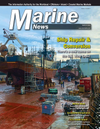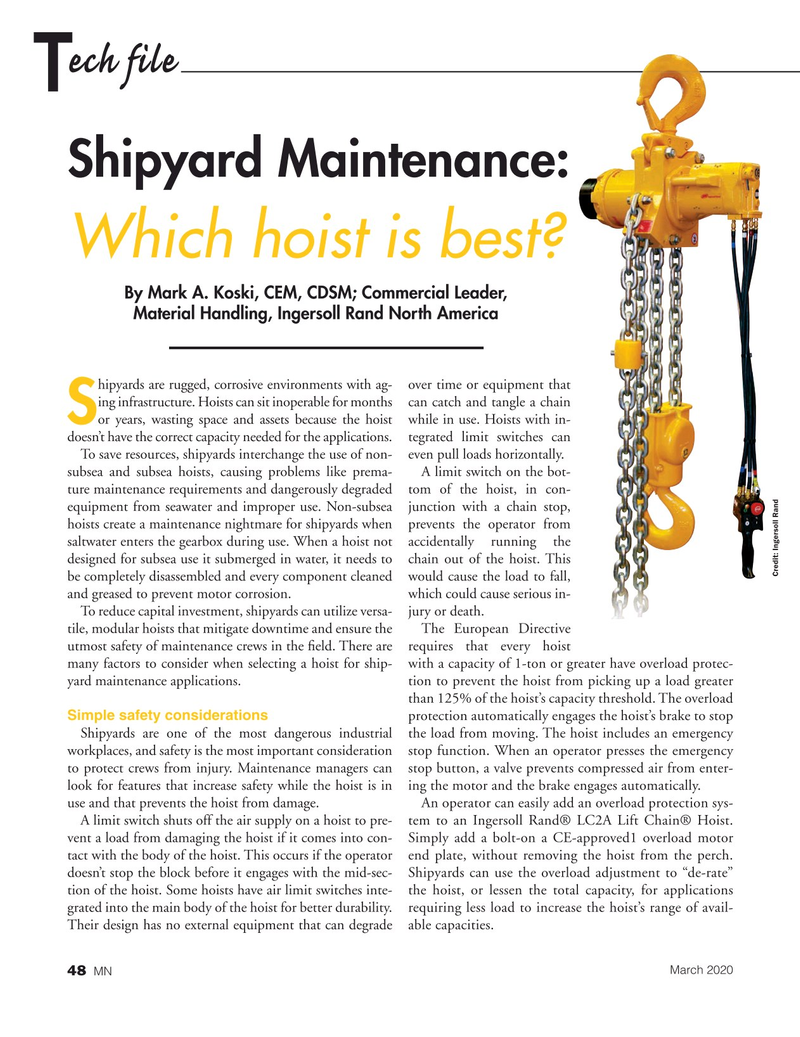
Page 48: of Marine News Magazine (March 2020)
Workboat Conversion & Repair
Read this page in Pdf, Flash or Html5 edition of March 2020 Marine News Magazine
ech file
T
Shipyard Maintenance:
Which hoist is best?
By Mark A. Koski, CEM, CDSM; Commercial Leader,
Material Handling, Ingersoll Rand North America hipyards are rugged, corrosive environments with ag- over time or equipment that ing infrastructure. Hoists can sit inoperable for months can catch and tangle a chain
S or years, wasting space and assets because the hoist while in use. Hoists with in- doesn’t have the correct capacity needed for the applications. tegrated limit switches can
To save resources, shipyards interchange the use of non- even pull loads horizontally.
subsea and subsea hoists, causing problems like prema- A limit switch on the bot- ture maintenance requirements and dangerously degraded tom of the hoist, in con- equipment from seawater and improper use. Non-subsea junction with a chain stop, hoists create a maintenance nightmare for shipyards when prevents the operator from saltwater enters the gearbox during use. When a hoist not accidentally running the designed for subsea use it submerged in water, it needs to chain out of the hoist. This
Credit: Ingersoll Rand be completely disassembled and every component cleaned would cause the load to fall, and greased to prevent motor corrosion. which could cause serious in-
To reduce capital investment, shipyards can utilize versa- jury or death.
tile, modular hoists that mitigate downtime and ensure the The European Directive utmost safety of maintenance crews in the ? eld. There are requires that every hoist many factors to consider when selecting a hoist for ship- with a capacity of 1-ton or greater have overload protec- yard maintenance applications. tion to prevent the hoist from picking up a load greater than 125% of the hoist’s capacity threshold. The overload
Simple safety considerations protection automatically engages the hoist’s brake to stop
Shipyards are one of the most dangerous industrial the load from moving. The hoist includes an emergency workplaces, and safety is the most important consideration stop function. When an operator presses the emergency to protect crews from injury. Maintenance managers can stop button, a valve prevents compressed air from enter- look for features that increase safety while the hoist is in ing the motor and the brake engages automatically. use and that prevents the hoist from damage. An operator can easily add an overload protection sys-
A limit switch shuts off the air supply on a hoist to pre- tem to an Ingersoll Rand® LC2A Lift Chain® Hoist. vent a load from damaging the hoist if it comes into con- Simply add a bolt-on a CE-approved1 overload motor tact with the body of the hoist. This occurs if the operator end plate, without removing the hoist from the perch. doesn’t stop the block before it engages with the mid-sec- Shipyards can use the overload adjustment to “de-rate” tion of the hoist. Some hoists have air limit switches inte- the hoist, or lessen the total capacity, for applications grated into the main body of the hoist for better durability. requiring less load to increase the hoist’s range of avail-
Their design has no external equipment that can degrade able capacities.
March 2020 48 MN

 47
47

 49
49
